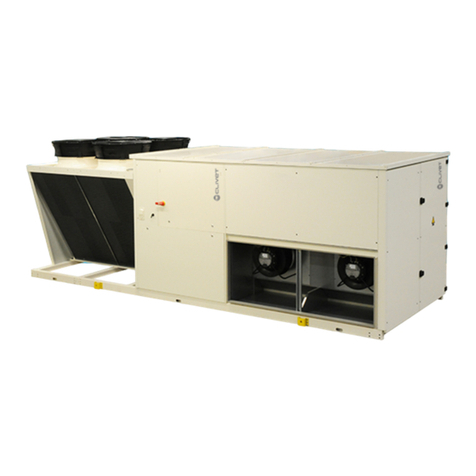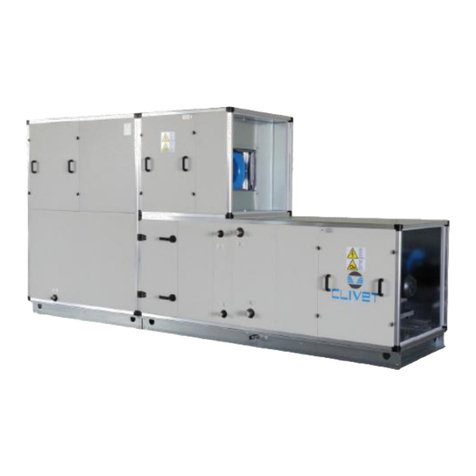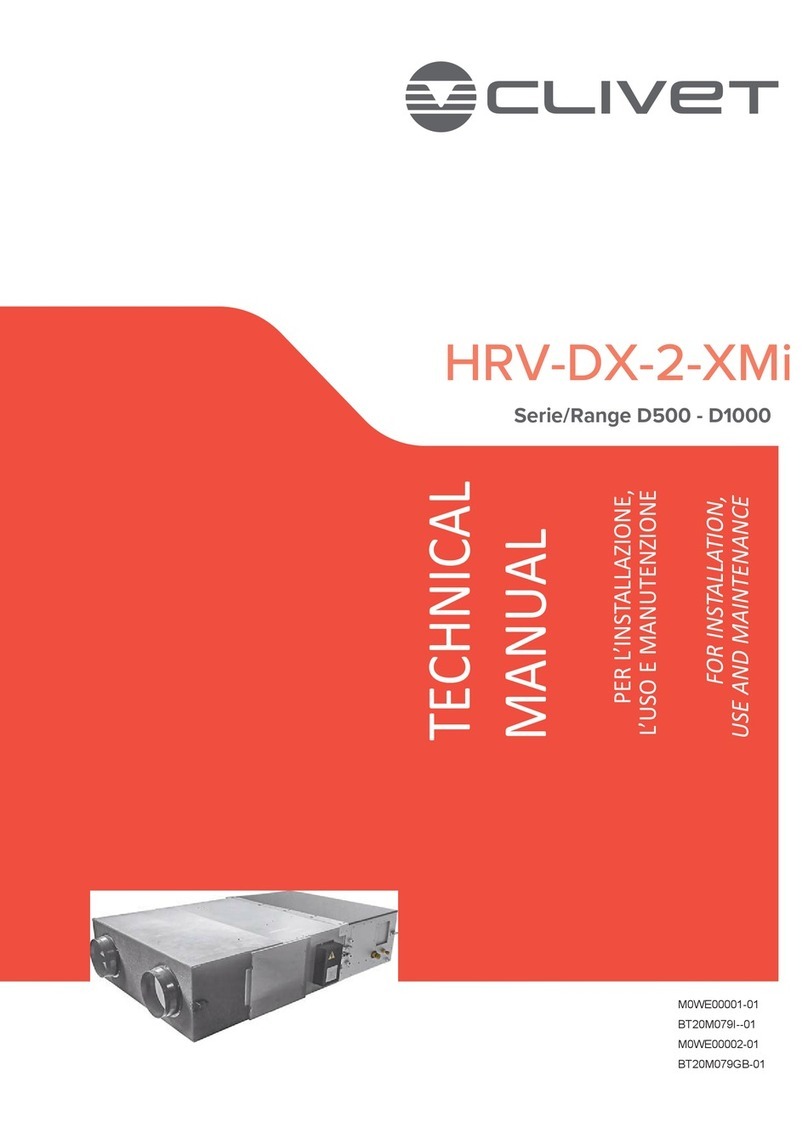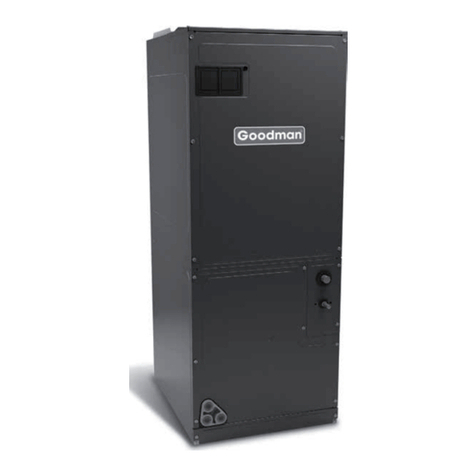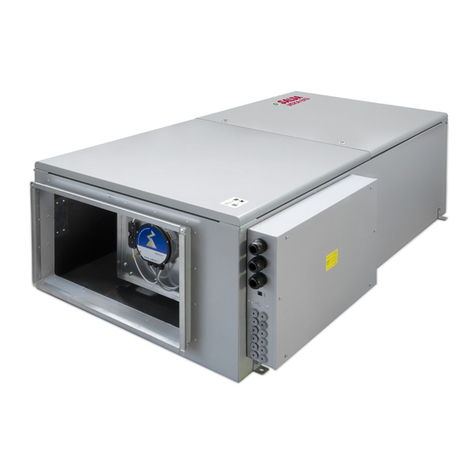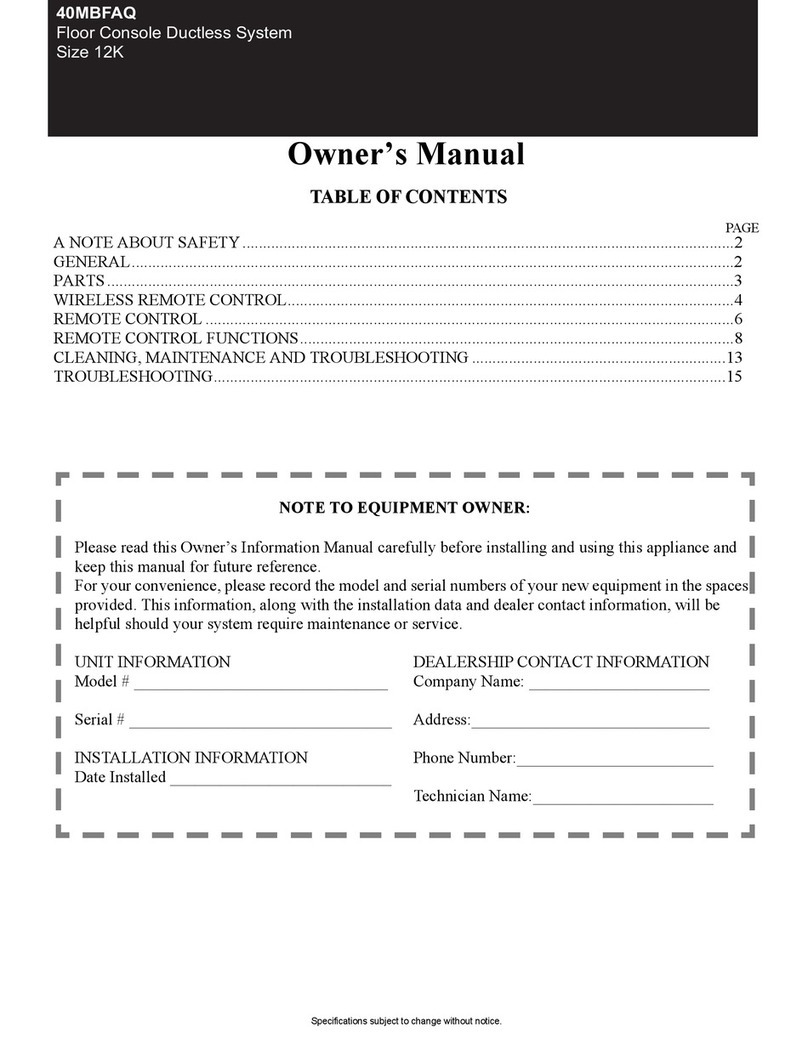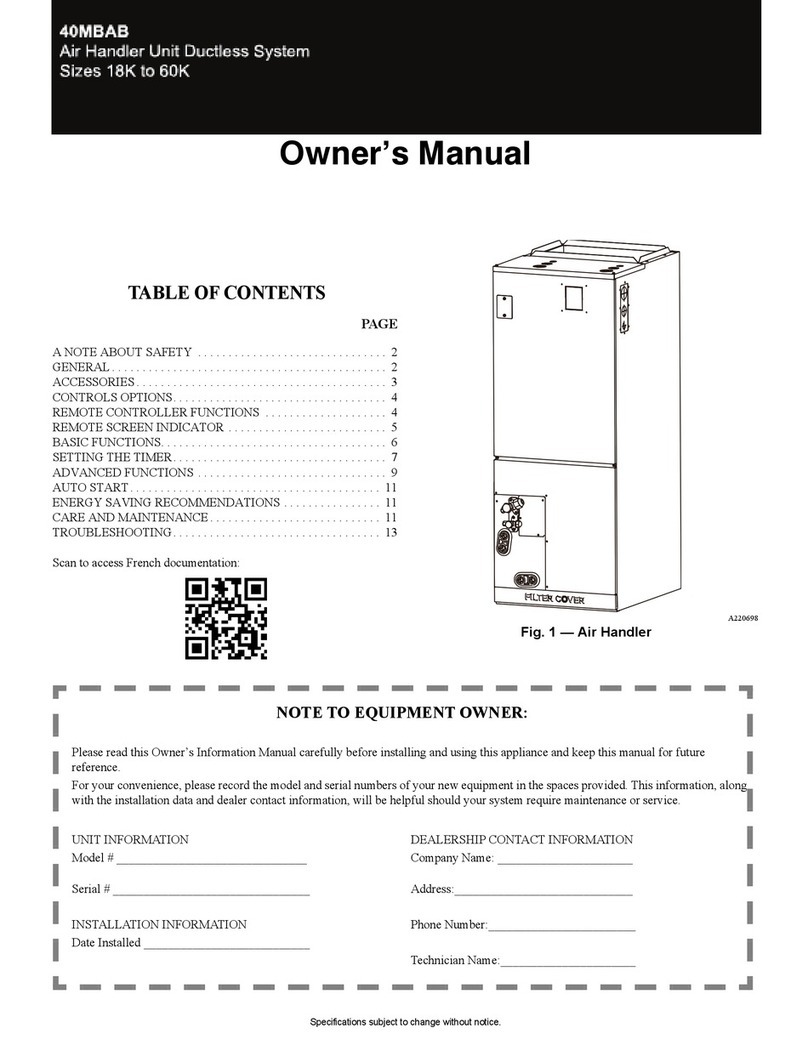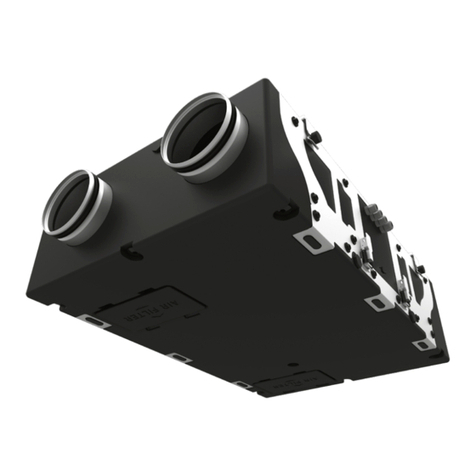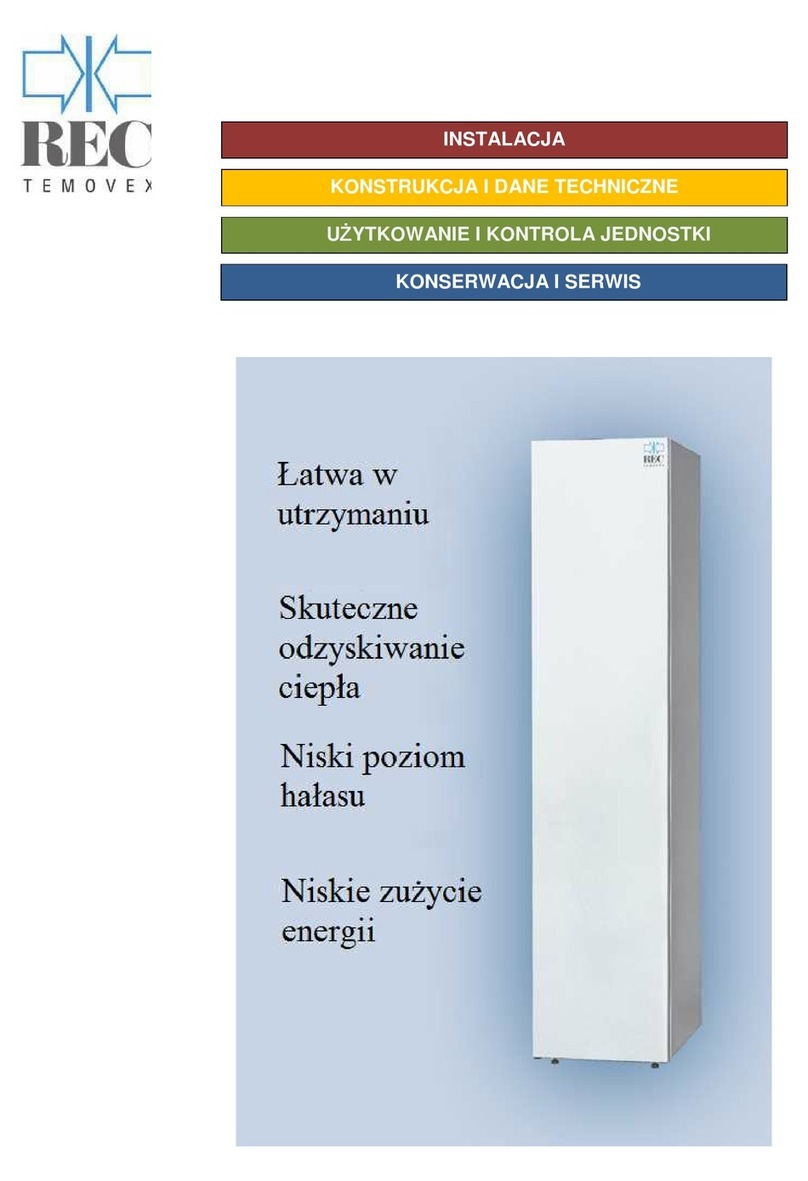CLIVET WSAN-YMi 91 Reference manual


MENU
FOR SERVICEMAN
OTHER HEATING SOURCE
MENU
FOR SERVICEMAN
OTHER HEATING SOURCE
MENU
FOR SERVICEMAN
DHW MODE SETTING
Domestic Hot Water
Boiler Solar panels
HEATING
mode
HEATING + DHW
mode
Quick guide
WSAN-YMi 91-141WSAN-YMi 91-141
Cascade unit
MENU
FOR SERVICEMAN
CASCADE SET
SW9
Master unit
SW9
Slave unit
AHS T1
P_s Solar IN
SV1 TBH P_d

MENU
FOR SERVICEMAN
ROOM THERMOSTAT = YES
MODE SETTING = YES
Thermostat
Running signal
Quick guide
WSAN-YMi 91-141
Defrosting signal
2-zone system - not mixed
2-zone system - mixed
Running
Defrost
PC
TW2 P_c SV3 Pc P_o SV2

The data contained in this manual is not binding and may be changed by the manufacturer without prior notice.
Reproduction, even is part, is FORBIDDEN © Copyright - CLIVET S.p.A. - Feltre (BL) - Italia
Dear Customer,
We congratulate you on choosing this product
For many years Clivet has been offering systems that provide maximum comfort, together with
high reliability, efficiency, quality and safety.
The aim of the company is to offer advanced systems, that assure the best comfort, reduce
energy consumption and the installation and maintenance cost for the life cycle of the system.
The purpose of this manual is to provide you with information that is useful from reception of the
equipment, through installation, operational usage and finally disposal so that this advanced
system offers the beat solution.
Yours faithfully.
CLIVET Spa

CONTENTS
1Product line-up 6
2Saftey considerations 7
3General information 11
4Installation 14
5Water connections 19
6Electrical connections 27
7Start-up and configuration 41
8Service information 61
9Maintenance 65
10 Trouble shooting 67
11 Controller user manual 78
12 Controller navigation menu 104
13 Cascade function 107
14 Modbus 110
15 General technical data 121
Dimensional drawings

Product line-up
Size Nominal kW Power supply
91 18 400TN 3-phase
101 22 400TN 3-phase
121 26 400TN 3-phase
141 30 400TN 3-phase

WARING
Read these instructions carefully before installation. Keep this manual in a handy for future peference.
Improper installation of equipment or accessories may result in electric shock, short-circuit, leakage, fire or other damage to the
equipment. Be sure to only use accessories made by the supplier, which are specifically designed for the equipment and make
sure to get installation done by a professional.
All the activitie described in this manual must be carried out by a licensed technician. Be sure to wear adequate personal
protection equipment such as gloves and safety glasses while installation the unit or carrying out maintenance activities.
qualificato devono essere effettuate sotto la supervisione della persona competente per l'uso di refrigeranti infiammabili.
Servicing shall only be performed as recommended by the equipment manufacturer. Maintenance and repair requiring the
assistance of other skilled personnel shall be carried out under the supervision of the person competent in the use of flammable
refrigerants.
Contact your dealer for any further assistance.
Caution:Risk of fire/flammable materials
DANGER
Indicates an imminently hazardous situation which if not avoided, will result in death or serious injury.
WARNING
Indicates a potentially hazardous situation which if not avoided, could result in death or serious injury.
CAUTION
Indicates a potentially hazardous situation which if not avoided, may result in minor or moderate injury. It is also used to alert against
unsafe practices.
NOTE
Indicates situations that could only result in accidental equipment or property damage.
The precautions listed here are divided into the following types.They are quite important, so be sure to follow them carefully.
Meanings of DANGER, WARNING, CAUTION and NOTE symbols.

DANGER
Before touching electric terminal parts, turn off power switch.
When service panels are removed, live parts can be easily touched by accident.
Never leave the unit unattended during installation or servicing when the service panel is removed.
Do not touch water pipes during and immediately after operation as the pipes may be hot and could burn your hands. To avoid injury,
give the piping time to return to normal temperature or be sure to wear protective gloves.
Do not touch any switch with wet fingers. Touching a switch with wet fingers can cause electrical shock.
Before touching electrical parts, turn off all applicable power to the unit.
WARNING
Tear apart and throw away plastic packaging bags so that children will not play with them.Children playing with plastic bags face
danger of death by suffocation.
Safely dispose of packing materials such as nails and other metal or wood parts that could cause injuries.
Ask your dealer or qualified personnel to perform installation work in accordance with this manual. Do not install the unit yourself.
Improper installation could result in water leakage, electric shocks or fire
Be sure to use only specified accessories and parts for installation work. Failure to use specified parts may result in water
leakage, electric shocks, fire, or the unit falling from its mount.
Install the unit on a foundation that can withstand its weight. Insufficient physical strength may cause the equipment to fall and
possible injury.
Perform specified installation work with full consideration of strong wind, hurricanes, or earthquakes. Improper installation work
may result in accidents due to equipment falling.
Make certain that all electrical work is carried out by qualified ersonnel according to the local laws and regulations and this
manual using a separate circuit. Insufficient capacity of the power supply circuit or improper electrical construction may lead to
electric shocks or fire.
Be sure to install a ground fault circuit interrupter according to local laws and regulations. Failure to install a ground fault circuit
interrupter may cause electric shocks and fire.
Make sure all wiring is secure. Use the specified wires and ensure that terminal connections or wires are protected from water
and other adverse external forces. Incomplete connection or affixing may cause a fire.
When wiring the power supply, form the wires so that the front panel can be securely fastened. If the front panel is not in place
there could be overheating of the terminals, electric shocks or fire.
After completing the installation work, check to make sure that there is no refrigerant leakage.
Never directly touch any leaking refrigerant as it could cause severe frostbite.Do not touch the refrigerant pipes during and
immediately after operation as the refrigerant pipes may be hot or cold, depending on the condition of the refrigerant flowing
through the refrigerant piping, compressor and other refrigerant cycle parts. Burns or frostbite are possible if you touch the
refrigerant pipes. To avoid injury, give the pipes time to return to normal temperature or, if you must touchthembe sure to wear
protective gloves.
Do not touch the internal parts (pump, backup heater, etc.) during and immediately after operation. Touching the internal parts
can cause burns. To avoid injury, give the internal parts time to return to normal temperature or, if you must touch them, be sure
to wear protective gloves.

CAUTION
Ground the unit.
Grounding resistance should be according to local laws and regulations.
Do not connect the ground wire to gas or water pipes, lightning conductors or telephone ground wires.
Incomplete grounding may cause electric shocks.
Gas pipes:Fire or an explosion might occur if the gas leaks.
Water pipes:Hard vinyl tubes are not effective grounds.
Lightning conductors or telephone ground wires:Electrical threshold may rise abnormally if struck by a lightning bolt.
Install the power wire at least 3 feet (1 meter) away from televisions or radios to prevent interference or noise. (Depending on the
radio waves, a distance of 3 feet (1 meter) may not be sufficient to eliminate the noise.)
Do not wash the unit. This may cause electric shocks or fire. The appliance must be installed in accordance with national wiring
regulations. If the supply cord is damaged, it must be replaced by the manufacturer, its service agent or similarly qualified
persons in order to avoid a hazard.
Do not install the unit in the following places:
Where there is mist of mineral oil, oil spray or vapors. Plastic parts may deteriorate, and cause them to come loose or water
to leak.
Where corrosive gases (such as sulphurous acid gas) are produced. Where corrosion of copper pipes or soldered parts may
cause refrigerant to leak.
Where there is machinery which emits electromagnetic waves. Electromagnetic waves can disturb the control system and
cause equipment malfunction.
Where flammable gases may leak, where carbon fiber or ignitable dust is suspended in the air or where volatile flammables
such as paint thinner or gasoline are handled. These types of gases might cause a fire.
Where the air contains high levels of salt such as near the ocean.
Where voltage fluctuates a lot, such as in factories.
In vehicles or vessels.
Where acidic or alkaline vapors are present.
This appliance can be used by children 8 years old and above and persons with reduced physical, sensory or mental capabilities
or lack of experience and knowledge if they are supervised or given instruction on using the unit in a safe manner and
understand the hazards involved. Children should not play with the unit. Cleaning and user maintenance should not be done by
children without supervision.
Children should be supervised to ensure that they do not play with the appliance. If the supply cord is damaged, it must be
replaced by the manufaturer or its service agent or a similarly qualified person.
DISPOSAL: Do not dispose this product as unsorted municipal waste. Collection of such waste seperatelly for special treatment
is necessary. Do not dispose of electrical appliances as municipal waste, use seperate collection facilities. Contact your local
goverment for information regarding the collection systems available. If electrical appliances are disposed of in landfills or
dumps, hazardous substance can leak into the groudwater and get into the food chain, damaging your health and well-being.
The wiring must be performed by professional technicians in accordance with national wiring regulation and this circuit diagram.
An all-pole disconnection device which has at least 3mm seperation distance in all pole and a residualcurrent device(RCD) with
the rating not exceeding 30mA shall be incorporated in the fixed wiring according to the national rule.

Confirm the safety of the installation area ( walls, floors, etc. ) without hidden dangers such as water, electricity, and gas.Before
wiring/pipes.
Before installation , check whether the user's power supply meets the electrical installation requirements of unit ( including
reliable grounding , leakage , and wire diameter electrical load, etc. ). If the electrical installation requirements of the product are
not met, the installation of the product is prohibited until the product is rectified.
When installing multiple air conditioners in a centralized manner, please confirm the load balance of the three-phase power
supply, and multiple units are prevented from being assembled into the same phase of the three-phase power supply.
Product installation should be fixed firmly, Take reinforcement measures, when necessary.
NOTE
About Fluorinated Gasses
This air-conditioning unit contains fluorinated gasses. For specific information on the type of gas and the amount, please refer to the
relevant label on the unit itself. Compliance with national gas regulations shall be observed.
Installation, service, maintenance and repair of this unit must be performed by a certified technician.
Product uninstallation and recycling must be performed by a certified technician.
If the system has a leak-detection system installed, it must be checked for leaks at least every 12 months. When the unit is checked
for leaks, proper record-keeping of all checks is strongly recommended.
This product has the fluorinated gas, it is forbidden to release to air.
Refrigerant type: R32;
Volume of GWP: 675.
GWP=Global Warming Potential
CAUTION
This unit contains fluorinated greenhouse gases.
Only certificated person is allowed to do installation, operation and maintenance.
Frequency of Refrigerant Leakage Checks
For unit that contains fluorinated greenhouse gases in quantities of 5 tonnes of CO2 equivalent or more,but of less than 50
tonnes of CO2 equivalent,at least every 12 months, or where a leakage detection system is installed, at least every 24 months.
Only certificated person is allowed to do installation, operation and maintenance.
Model
Factory charged refrigerant volume in the unit
Refrigerant/kg Tonnes CO2 equivalent
18 5.00 3.38
22 5.00 3.38
26 5.00 3.38
30 5.00 3.38

These units are used for both heating and cooling applications.
They can be combined with fan coil units, floor heating applications, low temperature high efficiency radiators, domestic hot water
tanks (not supplied) and solar kits (not supplied).
A wired controller is supplied with the unit .
The unit have a freeze prevention function that uses the heat pump and backup heater (option) to keep the water system safe from
freezing in all conditions. Since a power failure may happen when the unit is unattended, It's suggested to use anti-freezing flow switch
in the water system. (Refer to Water piping).
The backup heater can increase the heating capacity during cold outdoor temperatures.
The backup heater also serves as a backup in case of malfunctioning and for freeze protection of the outside water piping during
winter time.
The standard unit is without backup heater.
1. Heat pump capacity.
2. Required heating capacity (site dependent).
3. Additional heating capacity provided by backup heater.
Capacity/Load
Tbivalent Outdoor temperature
Not supplied
Room thermostat can be connected to the unit(room thermostat should be kept away from heating source when selecting the
installation place).
Not supplied
An optional solar kit can be connected to the unit.

Not supplied.
A domestic hot water tank(with or without booster heater) can be connected to the unit.
See table for specific tank.
If the tank volume is greater than 240L, the temperature probe (T5) should be installed at a position higher than half of the tank’s
height.
If the tank volume is less than 240L, the temperature probe should be installed at a position higher than 2/3 of the tank’s height.
The booster heater should be installed below the temperature probe.
The heat exchanger (coil) should be installed below the temperature probe.
Especially in case of considerable distances between the unit and the DHW storage tank, suitably size the connection pipes and take
care of the thermal insulation of the pipes themselves.
Outlet
Inlet
Booster heater (TBH)
Temperature probe
(T5)
Coil

* If the system is installed in parallel,Tbt1 must be connected and installed in the balance tank.
** When the units are connected in parallel, such as when the communication between the unit is unstable (such as an Hd fault code),
add a network matching wire between the ports H1 and H2 at the terminal of the communication system;
Sensors Tbt1, T5 and extension wire can be shared, sensors Tw2, Tsolar and extension wire can be shared, if these functions are
needed at the same time, please customize these sesors ande extension additionally.
Name Quantity
Adaptor 1
Y-shape filter 1
Water outlet connection pipe assembly 2
Wired controller 1
Tighten belt for customer wiring use 2
Thermistor for domestic hot water tank (T5) * 1
Extension wire for T5 1
Network termination resistor 1
Name Quantity
Thermistor for balance tank (Tbt1)* 1
Thermistor for Zone 2 flow temp. (Tw2) 1
Thermistor for solar temp. (Tsolar) 1

CAUTION
To avoid injury, do not touch the air inlet or aluminum fins of the unit.
Do not use the grips in the fan grills to avoid damage.
The unit is top heavy! Prevent the unit from falling due to improper inclination during handling.
The hook and barycenter of the unit should be on a
line in vertical direction to prevent improper
inclination
Make the rope go through the lifting holes from
both the right and left sides in the wooden collet
Be sure to confirm the model name and the serial number of the unit.
Due to relatively large dimensions and heavy weight, the unit should only be handled using lifting tools with slings.
The slings can be fitted into foreseen sleeves at the base frame that are made specifically for this purpose.

CAUTION
There is flammable refrigerant in the unit and it should be installed in a well-ventilated site. If the unit is installed inside, an additional
refrigerant detection device and ventilation equipment must be added in accordance with the standard EN378.
Be sure to adopt adequate measures to prevent the unit from being used as a shelter by small animals.
Small animals making contact with electrical parts can cause malfunction, smoke or fire.
Please instruct the customer to keep the area around the unit clean.
Select an installation site where the following condition sare satisfied and one that meets with your customer's approval.
Places that are well-ventilated.
Places where the unit does not disturb next-door neighbors.
Safe places which can bear the unit's weight and vibration and where the unit can be installed at an even level.
Places where there is no possibility of flammable gas or product leak.
The equipment is not intended for use in a potentially explosive atmosphere.
Places where servicing space can be well ensured.
Places where the units' piping and wiring lengths come within the allowable ranges.
Places where water leaking from the unit cannot cause damage to the location (e.g. in case of a blocked drain pipe).
Places where rain can be avoided as much as possible.
Do not install the unit in places often used as a work space. In case of construction work (e.g. grinding etc.) where a lot of dust
is created, the unit must be covered.
Do not place any object or equipment on top of the unit (top plate)
Do not climb, sit or stand on top of the unit.
Be sure that sufficient precautions are taken in case of refrigerant leakage according to relevant local laws and regulations.
Don’t install the unit near the sea or where there is corrosion gas.
When installing the unit in a place exposed to strong wind, pay special attention to the following.
Strong winds of 5 m/sec or more blowing against the unit's air outlet causes a short circuit (suction of discharge air), and this may have
the following consequences:
Deterioration of the operational capacity.
Frequent frost acceleration in heating operation.
Disruption of operation due to rise of high pressure.
When a strong wind blows continuously on the front of the unit, the fan can start rotating very fast until it breaks.
In normal condition,refer to the figures below for installation of the unit:

In case of strong wind and the wind direction can be fore-
seen,refer to the figures below for installation of the unit(any
one is OK):
Turn the air outlet side toward the building's wall, fence or
screen.
Make sure there is enough room to do the installation.
Set the outlet side at a right angle to the direction of the wind.
Prepare a water drainage channel around the foundation, to
drain waste water from around the unit.
If water does not easily drain from the unit, mount the unit on a
foundation of concrete blocks, etc. (the height of the
foundation should be about 100 mm (3.93 in).
If you install the unit on a frame, please install a waterproof
plate (about 100 mm) on the underside of the unit to prevent
water from coming in from the low side.
When installing the unit in a place frequently exposed to snow,
pay special attention to elevate the foundation as high as
possible
If you install the unit on a building frame, please install a
waterproof plate (not supplied) (about 100mm, on the
underside of the unit) in order to avoid drain water dripping.
(See the picture in the right).
NOTE
Unit is top heavy!
Try not to install on the building frame.
1. Construct a large canopy.
2. Construct a pedestal.
Install the unit high enough off the ground to prevent it from
being buried in snow.
As the outdoor temperature is measured via the outdoor unit
air thermistor, make sure to install the outdoor unit in the
shade or a canopy should be constructed to avoild direct
sunlight, so that it is not influenced by the sun’s heat,
otherwise protection may be possible to the unit.
To prevent exposure to wind, install the unit with its suction
side facing the wall.
Never install the unit at a site where the suction side may be
exposed directly to wind.
To prevent exposure to wind, install a baffle plate on the air
discharge side of the unit.
In heavy snowfall areas, it is very important to select an
installation site where the snow will not affect the unit. If lateral
snowfall is possible, make sure that the heat exchanger coil is
not affected by the snow (if necessary construct a lateral
canopy).

Φ10 Expansion bolt
Rubber shocking
proof mat
Solid ground
or roofing
(unit:mm)
Concrete basement
h≥100mm
Check the strength and level of the installation ground so that the unit may not cause any vibrations or noise during its operation.
In accordance with the foundation drawing in the figure, fix the unit securely by means of foundation bolts. (Prepare four sets each of
Φ10 Expansion bolts, nuts and washers which are readily available in the market.)
Screw in the foundation bolts until their length is 20 mm from the foundation surface.
This drain hole is covered by rubber plug.
If the small drain hole can not meet the
drainage requirements, the big drain hole
can be used at the same time.
NOTE
It's necessary to install an electrical heating belt if water can't drain out in cold weather even the big drain hole has opened.
Drain hole


Water component for corrosion limit on Copper
PH 7,5 ÷ 9,0
SO4-- < 100
HCO3- / SO4-- > 1
Total Hardness 8 ÷ 15 °f
Cl- < 50 ppm
PO4 3-< 2,0 ppm
NH3< 0,5 ppm
Free Chlorine < 0,5 ppm
Fe3 +< 0,5 ppm
Mn++ < 0,05 ppm
CO2< 50 ppm
H2S< 50 ppb
Temperature < 65 °C
Oxygen content < 0,1 ppm
Sand 10 mg/L
0.1 to 0.7mm max diameter
Ferrite hydroxide
Fe3O4 (black)
Dose < 7.5 mg/L 50% of mass
with diameter < 10 µm
Iron oxide Fe2O3
(red) Dose < 7.5mg/L
confirming to local regulations
Langelier (IL) index between 0 and +0.4
within the limits indicated by table
The water quality must be checked by qualified personnel.
CAUTION
Circulators operate best with clean, good quality tap water.
The most frequently occurring factors which may have a
negative effect on heating water can be oxygen, lime,
sludge, acidity level and other substances (including
chlorides and minerals).
In addition to the heating water quality, the installation also
plays a significant part.
If the water hardness is high install a system suitable to
preserve the unit from harmful deposits and limestone
formations.
If necessary, fit a water softener to reduce water hardness.
Before making the water connections to unit clean carefully the
system with specific and effective products for removing
residues or impurities that could affect the operation. The
existing systems must be free from sludgs, contaminants and
protected against foulings.
In the case of new installations, it is first of all crucial to flush
the entire installation thoroughly (without the circulator
mounted) before the central installation is commissioned. This
will remove residues from the installation process (weld, slag,
fitting products…) and preservatives (including mineral oil).
The system shall then be filled with clean, good quality tap
water.
If a new boiler or heat pump is being installed in an existing
heating system, the system must be flushed to avoid particles
presence, sludge and other problems in the installation. Where
applicable, flushing shall be done before the new application is
installed. Loose dirt can only be removed where there is
sufficient flow. Flushing will therefore take place section by
section. Special attention must also be paid to “blind spots”,
where there is only a small amount of flow and where a lot of
dirt can be accumulated. The system shall then be filled with
clean, good quality tap water. If after the flushing the quality of
the water in an existing installation still proves to be
inadequate, certain measures must be taken to avoid
circulator problems. One option for removing pollution is to
install a filter. Various kinds of filters are available for this. A
screen filter is designed to trap large dirt particles. This filter is
usually placed in the full flow part of the system. A fabric filter
on the other hand, is designed to trap finer particles.
The warranty does not cover damages caused by limestone
formations, deposits and impurities from the water supply and /
or failure from failed system clearing to clean system.

1Air purge valve
2Expansion vessel
3Pump
4Safety valve
5Manometer
6Flow switch
7Refrigerant gas connection
8Refrigerant liquid connection
9Plate heat exchanger
10 Water outlet connection
11 Water inlet connection
12.1 Electrical resistance
12.2 Electrical resistance
12.3 Electrical resistance
TW_out
TW_in Water temperature sensors
T2B
T2 Refrigerant temperature sensors
This manual suits for next models
3
Table of contents
Other CLIVET Air Handler manuals
Popular Air Handler manuals by other brands
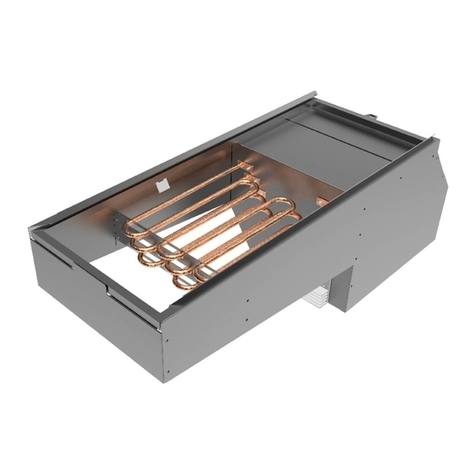
System air
System air Topvex Series installation instructions
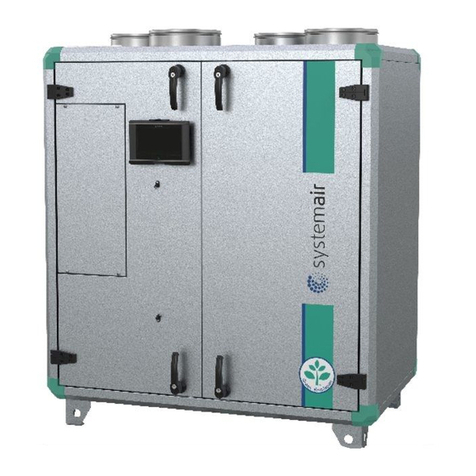
System air
System air Topvex 1000 R Operating and maintenance instructions
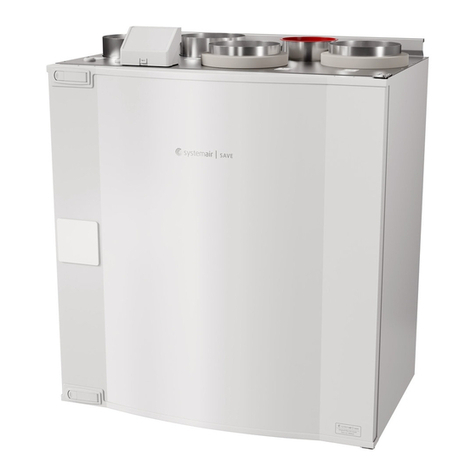
System air
System air Villavent Combini EC Installation description
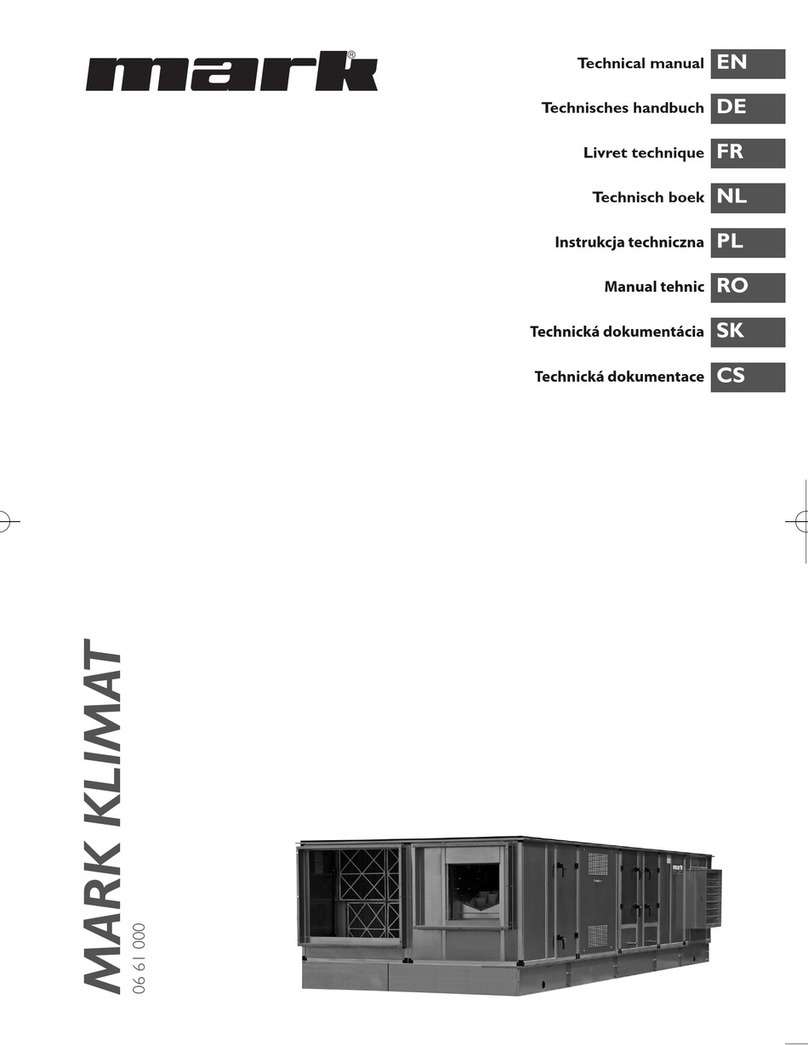
Mark
Mark Klimat 15-15 Technical manual

Blue Ridge
Blue Ridge BM12MCD installation manual
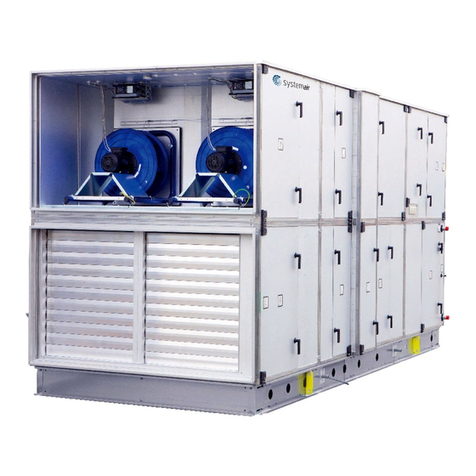
System air
System air Danvent DV-10 user manual
